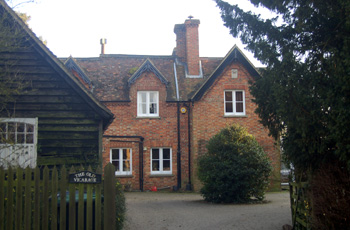Husborne Crawley Vicarages
![The Vicarage about 1920 [X21/758/3]](/CommunityHistories/HusborneCrawley/HusborneCrawleyImages/The Vicarage about 1920 [X21-758-3].jpg)
The Vicarage about 1920 [X21/758/3]
The first mention of a vicarage at Husborne Crawley is in an inventory of church property in the archdeaconry of 1607 [ABE1]. The building comprised four bays, all chambered and boarded, in other words, each with a ground and first floor. The building was built of timber (probably meaning that it was half-timbered with plaster infill) and had a tiled roof. The vicarage stood between lands of Robert Thompson on the north and south, abutted north-west onto the churchyard and south on a close belonging to the vicarage. This would suggest that the 19th century vicarage is built on approximately the same site as its predecessor.
The ground floor rooms comprised a hall, a parlour, a kitchen and a buttery as well as a "little room at the south end". A chamber on the first floor lay above each of these rooms. Outside stood a timber and thatched barn with three bays.
Volume 81 published by the Bedfordshire Historical Records Society (2002) is devoted to returns made during episcopal visitations to the county by the Bishop of Lincoln in the early 18th century, edited by former County Archivist Patricia Bell. In 1706 and 1709 the return noted that the incumbent did not live in the parish which was served by a curate. One of the reasons for this was probably the state of the vicarage. In an archdeaconry survey of 1707 the building, no doubt the same as a hundred years before, was imply described as "very much decayed" [ABEii (II 490)]. In 1709 there was a petition to sell the buildings materials of the "ruinous vicarage" [ABF3/115].
In 1717 Rev. Thomas Wilkinson wrote: "I do not Personally reside upon my Cure, there being no Parsonage House nor a convenient place to board at in the Parish".
It seems that Husborne Crawley went without a vicarage for at least 150 years. No doubt in that time the curates and vicars lived in Ridgmont. This probably helps to explain why nonconformity, both Baptists and later Primitive Methodists took such a hold in the parish. Eventually the Duke of Bedford erected a new vicarage in 1851. The bills for the building dating from 1851 to 1853 are held at Bedfordshire and Luton Archives and Records Service in the Russell (Dukes of Bedford) archive [RBox(vouchers)402].
The Rating and Valuation Act 1925 specified that every building and piece of land in the country was to be assessed to determine its rateable value. The valuer visiting the vicarage [DV1/C53/90] found that it lay in just under a quarter of an acre. It comprised a hall, three reception rooms, a kitchen, a scullery with a cellar beneath, five bedrooms and a bathroom with hot and cold water. A traphouse, a stable used as a shed and a wood shed all lay outside. Water was laid on but there was no electricity, lighting being by oil lamps. Sanitation was to a cesspool.
Sadly Bedfordshire and Luton Archives and Records Service currently [2012] has no material on the vicarage in the Husborne Crawley parish archive [P49]. The Diocesan Yearbook for 1975/76 gives Rev. Naylor as Vicar of Husborne Crawley and his address as Husborne Crawley Vicarage. The next yearbook, 1976/77 gives the Rector of Aspley Guise, Rev. Hardy (later Bishop of Lincoln) as being in charge of both Husborne Crawley and Ridgmont. He officially held the three parishes in plurality from 1980. This suggests that the vicarage was sold in 1977 or later. It is now a private house called, appropriately, The Old Vicarage.
 The Old Vicarage January 2011
The Old Vicarage January 2011